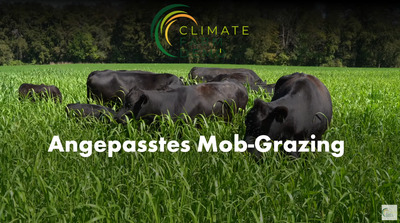{Tool} High-grass grazing or mob grazing: Adapting pasture management to the consequences of climate change. [Hochgrasbeweidung oder Mob grazing: Weidebewirtschaftung an die Folgen des Klimawandels anpassen.] Creator(s): Alföldi, Thomas. Issuing Organisation(s): FiBL - Research Institute of Organic Agriculture. (2024)
![[thumbnail of 2024-08-22 13_54_23-(87) High-grass grazing or mob grazing_ Adapting pasture management to the conse.png]](/53743/1.hassmallThumbnailVersion/2024-08-22%2013_54_23-%2887%29%20High-grass%20grazing%20or%20mob%20grazing_%20Adapting%20pasture%20management%20to%20the%20conse.png)  Preview |
Image (PNG)
- Cover Image
- English
2MB |
|
Video (MP4)
- Published Version
- German/Deutsch
155B | |
|
Video (MP4)
- Published Version
- English
155B |
Document available online at: https://www.youtube.com/watch?v=Cl5bf05WmRY
Summary
In this video, Silvan and Stefan Schreiber explain how they had to rethink their previous grazing system due to the consequences of climate change. To counter increasingly extreme weather conditions, Silvan and Stefan introduced the mob grazing system on their Stone Ranch.
Summary translation
In diesem Video erklären Silvan und Stefan Schreiber, wie sie aufgrund der Folgen des Klimawandels ihr bisheriges Weidesystem überdenken mussten. Besonders besorgt waren sie über die zunehmende Dürre im Sommer verbunden mit starken Regenfällen. Um diesen zunehmend extremen Wetterbedingungen entgegenzuwirken, führten Silvan und Stefan auf ihrer Stone Ranch das Mob-Weidesystem ein.
| EPrint Type: | Practice tool |
|---|---|
| Teaser: | Learn more about the characteristics and benefits of mob grazing systems. |
| What problem does the tool address?: | Grazing systems are increasingly threatened by frequently dry and hot summers, combined with heavy rainfall. |
| What solution does the tool offer?: | The characteristics of mob grazing are: a short stocking time and a long resting time. In contrast to the classic mob grazing system, the animals eat the plants a little deeper. Mob grazing is intended to increase the humus content in the soil, which in turn improves the water storage capacity. Other advantages mentioned by farmers include good herd control and benefits for calf health. However, there are also challenges such as shading the animals, providing drinking troughs and mice infestation in permanent pastures. Mob grazing is particularly suitable for farms in dry summer areas. However, it requires a certain willingness on the part of farmers to take risks and experiment. |
| Country: | Switzerland |
| Type of Practice Tool: | Video |
| Keywords: | cattle, grazing, climate change, climate change adaptation, climate-smart agriculture, drought resistance, resilience |
| Agrovoc keywords: | Language Value URI English cattle http://aims.fao.org/aos/agrovoc/c_1391 English grazing http://aims.fao.org/aos/agrovoc/c_25243 English climate change http://aims.fao.org/aos/agrovoc/c_1666 English climate change adaptation http://aims.fao.org/aos/agrovoc/c_1374567058134 English climate-smart agriculture http://aims.fao.org/aos/agrovoc/c_1361789093890 English drought resistance http://aims.fao.org/aos/agrovoc/c_2392 English resilience http://aims.fao.org/aos/agrovoc/c_1374480530924 |
| Subjects: | Animal husbandry > Production systems > Beef cattle Environmental aspects |
| Research affiliation: | Switzerland > FiBL - Research Institute of Organic Agriculture Switzerland > Animal > Animal welfare & housing > Grassland-based livestock systems European Union > Horizon Europe > OrganicAdviceNetwork > selected tools European Union > Organic Farm Knowledge |
| Horizon Europe or H2020 Grant Agreement Number: | 101134850 |
| Related Links: | https://organic-farmknowledge.org/tool/53743, https://organic-farmknowledge.org/tool/42819, https://organic-farmknowledge.org/tool/43978, https://terrabc.org/tiere/tierhaltung/wiederkaeuer/rinder/mob-grazing-auf-der-fruchtfolgeflaeche/, https://www.facebook.com/organicfarmknowledge/posts/pfbid02CRzdfwLRG9iAHUT5AeeiiyoS6AssEXnCnuUq3jFL7DXAbi4iAq9AJr2DPz6jFKQKl, https://lnkd.in/p/eNiz_pKp |
| Project ID: | OFK |
| Deposited By: | Rüger, Madelaine Lea |
| ID Code: | 53743 |
| Deposited On: | 29 Aug 2024 07:30 |
| Last Modified: | 22 Sep 2025 14:04 |
| Document Language: | English, German/Deutsch |
| Status: | Published |
Repository Staff Only: item control page


